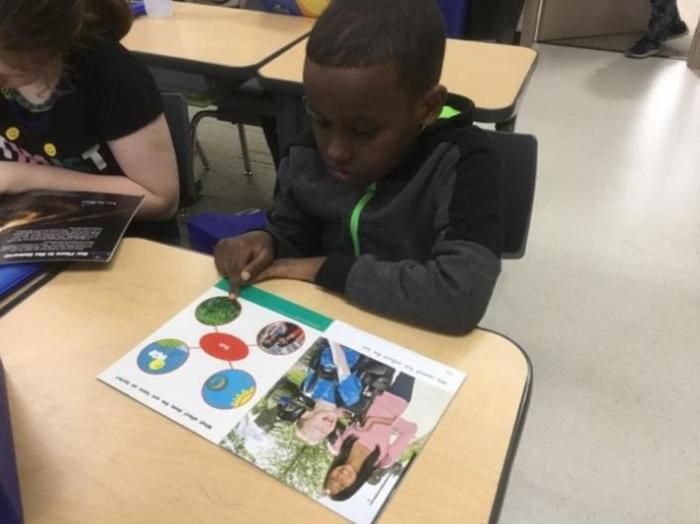Graphic organizers, think-pair-share, defining fiction and nonfiction, and summarization strategies are all common practices in many classrooms. Liz Hanson, an educator in ISD 196, analyzes how the use of these practices has changed throughout her career from a classroom teacher to a teacher of English language learners. Liz acknowledges EL colleagues, Bridget Coleman and Alena Hyams, and co-teacher, Jennifer Faber, for the collaboration that led to the changes in practice described in this article.
Key words: literacy, ELLs, critical thinking, graphic organizers, discourse
Over the course of my nearly two-decade career, literacy practices have come and gone, evolved, or cycled back around again. I continually do what I think is best for learners, based on my current understanding, but wonder if I am sometimes just going through the motions and not using some instructional practices to their highest capacity.
There are four common practices I have used since the early stages of my profession. These practices are the use of graphic organizers—visual representations used to categorize or show the connections between different pieces of information (Zwiers, 2011); think-pair-share—the process of pausing within a lesson and allowing students to organize and communicate their thoughts about content being taught (Lyman, 1981; Zwiers, 2014); defining nonfiction to distinguish it from fiction; and summarizing. Initially, as an elementary classroom teacher of grades three through six, I utilized these practices with my students in order to assess understanding of content. More recently, as an educator of English language learners (ELLs), my perspective has changed. I now see these practices as ways to support language acquisition. In addition, I’ve begun to wonder:
How might I use these educational practices to their full potential to support the development of academic discourse and critical thinking for my intermediate ELLs?
Graphic Organizers: Mapping Thinking for Academic Discourse
As a classroom teacher, graphic organizers were ever present scaffolds for my students to organize ideas within multiple content areas. These tools, which often times were copied for students to fill out, provided a place to stop and jot down ideas, and for me, as the educator, to check for student understanding of content.
My third graders were able to independently compare people, events, or concepts with a Venn diagram, show a sequence with a flow chart, or show cause and effect with a T-chart. For them, it was a simple task completion. Unknowingly, I taught them that this was all graphic organizers could do: show understanding.
Several years later, my thoughts about the purpose and intent of graphic organizers shifted from a tool to show understanding to a tool to prepare for discussion and writing (Fisher & Frey, 2018). Now, with my fourth grade ELLs, I demonstrate a box and bullets (Ehrenworth, 2013) for students to organize their ideas for a paragraph with a main idea and supporting details. Instead of giving them a printed graphic organizer, I show them how to create the box and bullets in their reader’s notebook, so they may transfer this organizer to other contexts. The students then take the phrases and sentences they have constructed in their box and bullets and turn them into a paragraph with a topic sentence and supporting ideas.
Additionally, my third graders use a double entry journal to show a quote from the text in the first column and what the text made them think of in the second column in order to extend their responses from the literal meaning to more of the inferential implications. I confer one-on-one with individual students to have them practice sharing their thinking with me orally. Finally, this graphic organizer grounds them in their conversation when they share with a partner at the end of our Readers Workshop.
There is much greater cognitive demand and linguistic complexity within the synthesizing of information and transforming the notes on the graphic organizer into sentences and paragraphs (Zwiers, 2011). For our intermediate ELLs, the power is not in the note-taking of single words or phrases, which is how I had previously utilized this tool; rather, it is within the higher-level thinking of writing simple, compound, and complex sentences around a topic in one or multiple paragraphs. Figure 1 shows a student preparing to write and speak about how the sun helps the earth.

Think-Pair-Share: Tailoring Language Supports for Learners
Within a whole group lesson, it is fairly easy for the teacher to do all of the talking. Think-pair-share provides opportunities for students to participate in the lesson in a meaningful way (Zwiers, 2011, 2014).
I have always known that speaking was important for learning (City, 2014; Nichols, 2006; Zwiers, 2011) and that think-pair-share was a strategy I could incorporate to foster more talk in my classroom. For numerous years during whole group lessons, I modeled a new strategy or skill, asked my students a question, encouraged them to sit facing one another, and simply talk. During the conversations, I meandered around listening in and prompting students to elaborate. In the end, I selected one or two pairs to share out their ideas to the class.
What I was not always aware of was how unproductive these conversations could actually be. If I really looked closely, often times they involved one student monopolizing the entire conversation, students speaking in short phrases or utterances, both students sitting in silence, or a conversation that was completely off topic.
Through careful observation of students and conversations with other teachers of ELLs, I’ve concluded that:
- I cannot assume that all students know how to carry an academic conversation, native English speakers included; and
- that just stopping and asking a question does not provide enough linguistic support for students developing academic English.
As argued by Walqui and Heritage (2018), “teachers must find meaningful ways to provide students learning opportunities that engage them in productive talk and then listen carefully to the language they use in order to support their continued growth” (p. 20).
In order to investigate this further, my English Language (EL) colleagues and I participated in a lesson study where we co-planned a fifth-grade reading lesson together in February 2019 with the emphasis of listening to paraphrase or clarify meaning (Zwiers, 2011) during a think-pair-share. For this lesson, we used the text One Green Apple by Eve Bunting and Ted Lewin (2006), a text in the fifth-grade author study unit, and embedded several language scaffolds of intentionally pairing partnerships, providing sentence frames for clarifying, paraphrasing, and explaining, a demonstration of the process, and opportunities for oral rehearsal before writing.
As a team, we analyzed the fifth-grade benchmarks in order to brainstorm a question that was elaborate enough to foster a conversation (Billings & Roberts, 2014; Fisher & Frey, 2014), yet simple enough that it would not involve too much new content. We knew that teaching a new structure for talk would provide enough cognitive demand, so the question should be as accessible as possible (City, 2014). We created a visual card for the listener and the speaker so each had sentence frames to support their oral response with their partner (Zwiers, 2011). In addition, we planned the partnerships so that an ELL would have a native English speaker as a model. We structured the think-pair-share so that the native English speaker spoke first, giving the ELL an opportunity to borrow words or phrases from their peer (Bondie, Gaughran, & Zusho, 2014; Fisher & Frey, 2014; Zwiers, 2011). Finally, we carefully thought out how we would demonstrate the conversation for the students so they could see what the process would look like and sound like (Fisher & Frey 2014; Wright, 2016). After participating in the think-pair-share, we then asked students to put their thoughts and ideas into writing while we walked around and conferred.
As a result of this lesson study, we found that incorporating multiple language scaffolds supported ELLs in their ability to listen, speak, and write using the academic discourse of language arts to discuss the question: How is the main character feeling? How do you know? The classroom teacher and one of our colleagues who observed three ELLs noticed an increased amount of engagement and academic discourse produced compared to many previous lessons.
Through research and the experience of this lesson study, I’ve discovered that the key to think-pair-share is taking the time to intentionally think about what language you want students to be able to produce and what language supports will aide students in meeting that objective. Setting up the necessary scaffolds for all learners, especially ELLs (Billings & Roberts, 2014), will make for more targeted and productive conversations. Examples of language supports are in Figure 2.
Defining Fiction and Nonfiction: Laying the Foundation for Academic Thinking, Reading, and Writing
During my first few years as an educator, a majority of my reading instruction revolved around fiction texts, unless my students were in a social studies or science unit. My guided reading books, read alouds, and book clubs were nearly all narratives. Then, with the introduction of the Common Core standards (National Governors Association Center for Best Practices & Council of Chief State School Officers, 2010), I was much more intentional about including more nonfiction text into my whole group and small group instruction. My students could nearly always identify which books were fiction or nonfiction, but could not always defend their thinking with a reason, or their rationale was extremely limited. Additionally, my students were not always using what they knew about genre to support their understanding of the text or their construction of a piece of writing.
Beers and Probst (2015) encourage teachers to co-create a definition of nonfiction with their students. A noticing of theirs, and a practice I have also been guilty of, is the perpetuation of the misconception that fiction is fake and nonfiction is true or real. I’ve heard this countless times from students while administering diagnostic reading assessments. By students thinking that nonfiction text is real or true, they tend to believe everything they read, which makes it more challenging to critically analyze the text to find out whether it is valid, the author is credible, and what the purpose of the writing may be. A sample definition of nonfiction I use now is, “in nonfiction text, an author teaches the reader facts and information about a topic based on his/her research and perspective.”
Beyond just identifying fiction and nonfiction, I also make sure that my ELLs can determine the subgenres of fiction and nonfiction and that they are able to justify their claim with evidence. We carefully study books of fiction from realistic fiction, fantasy, and historical fiction to nonfiction books which are expository, biographical, persuasive, procedural, or narrative nonfiction. Students read and hear several books within each genre throughout the year.
I often ask my students questions like:
“Does this text have facts and information about a topic or is it about a character who solved a problem? Are these characters and settings realistic or are these characters and settings you would not meet in our world? What topic did this author want to inform us about? What facts and information did this author most want us to know?”
These questions can help students to distinguish the genre and the purpose of writing the text. They are also especially helpful when parsing out the difference between the subgenres of realistic fiction and narrative nonfiction, which tends to be more challenging to differentiate for several students.
In my EL co-taught class, all fourth graders are expected to explain their thinking about the genre of a text and support their thinking with evidence. Students use a checklist (Calkins, 2015) and sentence frames, created by my co-teacher and me to assist their writing or speaking (see Figure 2). They then self-assess, peer assess, and receive a final grade from us. We have found that by studying the characteristics of genre in addition to stating a claim and defending that claim with more than one reason has solidified our students’ understanding of an author’s use of genre.
Being able to identify the genre of a text goes beyond just fiction and nonfiction. Students can analyze the text for subgenres, compare and contrast the choices of different authors writing about the same topic, read widely across genres and within genres, and critically read works of nonfiction instead of believing the printed word as being true.
How Text Structure, Text Features, and Signal Words Support Determining Importance in Expository Nonfiction
Retelling, a precursor to recounting and summarizing (Common Core, 2010), is the practice of telling events in order from the text. There are several ways this has historically been done in primary grades. One method is using the sentence frames of: In the beginning, In the middle, In the end (Reading Rockets, n.d). Another way this is introduced is telling the events from a story in order across five fingers, with each finger representing an event from the text (University of Pittsburgh School of Education, n.d). A final way is a story map (Reutzel, 1985) which may include the sentence frames of beginning, middle, and end, or a sequence of steps similar to telling across five fingers. The challenge I’ve found is taking students from the concept of retelling events of a story to determining importance from that text as a summary. Often times, students think they should retell when in fact they are being asked to summarize (Beers & Probst, 2015).
Summarizing, a way to state the important information from the text in a concise way (Fountas & Pinnell, 2017), is a skill that I have explicitly taught numerous times to intermediate students. One method I have taught general education students is by using a 25-word summary where students write about the character and what that character did in the chapter or episode of the text. Students carefully revise their word choice to keep the summary brief. Many students start out with 40-word summaries and would have to continue to narrow down and weed out events and ideas that were unimportant. Another method I’ve utilized was the Somebody wanted, but, so, finally. Unfortunately, neither of the methods necessarily helped the students decipher which parts were important and which parts were details. In addition, the strategies I used to summarize fiction didn’t necessarily transfer to nonfiction. And, in some cases, we floundered when trying to summarize a fiction text that didn’t have a traditional story structure.
Therefore, in addition to identifying and providing evidence to support their claim of the genre, my students and I also spend a lot of time looking at how the author organizes the text, or the text structure, in order to determine importance and summarize (Ouellette-Schramm, 2015). While fiction texts have mainly one text structure, nonfiction texts can be organized in many different ways. The nonfiction text structures we would expect to see in nonfiction are categorical, description, sequential, comparison, cause and effect, problem and solution, and question and answer (Fountas & Pinnell, 2017). The skill of summarizing nonfiction texts is beneficial for students in order to be college and career ready and is one that requires a lot of synthesis (Schwartz, Mendoza, & Meyer, 2017).
In my fourth-grade guided reading group, my English language learners think about the text features by looking at clues like the title or heading, bold words, and visuals on the page before they read so they can anticipate the knowledge the author might share or some of the concepts or ideas that may be introduced. When students do this, it seems to frame their thinking and they are actively able to modify or adjust their understanding of the text based on new clues as they read. They have also found it much easier to determine the important parts after reading (Kim & Clariana, 2017). In addition, we analyze the text structure, which supports the student in organizing their summary like a comparison, description, or problem solution. Figure 4 contains a writing sample demonstrating a student anticipating what they will read based on text structure, organization, and features before reading, along with their summary after reading.
Signal words were integral in a flash fiction unit I launched this spring with third graders. These students wrote a 100-word fantasy story within their astronomy unit based on a narrative text structure with a problem and solution. Students were asked to use signal words like but, however, unfortunately to show the problem in the text. With the emphasis on writing with text structure, and the utilization of signal words, the act of writing made explicit how writers use text structure and signal words so that it is clearer to them how important these structures are to notice as a reader.
Refining Our Practice
My previous ways of using graphic organizers, think-pair-share, defining fiction and nonfiction, and summarization strategies may have unintentionally had students speaking and writing in general words or phrases instead of the complex academic discourse we expect from our intermediate ELLs. It also potentially stifled critical thinking skills to analyze and determine importance in nonfiction text.
Readers use what they know about how texts work in order to predict, infer, summarize, and synthesize important information. Writers use what they know about texts while writing text in a specific genre. By taking this time to use graphic organizers in preparation for speaking and writing, utilizing think-pair-share with language supports to allow for more productive conversations, defining fiction and nonfiction to support more critical thinking, and explicitly teaching about how readers and writers use text structure, text features, and signal words, it lays a solid foundation for knowledge of genre, research, and critical analysis of all texts. The refinement of these practices has been paramount in my career as an educator of ELLs. I have witnessed countless students take on some of these strategies and make them their own. I am continually impressed by how the use of these practices has lifted the level of academic speaking and writing discourse for my ELLs.
References:
Beers, K., & Probst, R. (2015). Reading nonfiction: Notice and note stances, signposts, and strategies. Portsmouth, NH: Heinemann.
Billings, L., & Roberts, T. (2014). From mindless to meaningful: Whole class discussions can be valuable rituals that students look forward to. Educational Leadership, 72(3). Retrievable from http://www.ascd.org/publications/educational-leadership/nov14/vol72/num03/From-Mindless-to-Meaningful.aspx
Bondie, R., Gaughran, L., & Zusho, A. (2014). Fostering English learners’ confidence. Educational Leadership, 72(3). Retrievable from http://www.ascd.org/publications/educational-leadership/nov14/vol72/num03/Fostering-English-Learners’-Confidence.aspx
Bunting, E., & Lewin, T. (2006). One green apple. New York: Clarion Books.
Calkins, L. (2015). Reading pathways, performance assessments and learning progressions: Grades 3-5. Portsmouth, NH: Heinemann.
City, E. A. (2014). Talking to learn. Educational Leadership, 72(3). Retrievable from http://www.ascd.org/publications/educational-leadership/nov14/vol72/num03/Talking-to-Learn.asp
Ehrenworth, M. (2013). Evidence-based argument: Raising the level of logic, critical thinking, and argument writing in classrooms across a school. Teachers College Reading and Writing Project. Columbia University, New York, NY.
Fisher, D., & Frey, N. (2014). Speaking volumes! Educational Leadership, 72(3). Retrievable from http://www.ascd.org/publications/educational-leadership/nov14/vol72/num03/Speaking-Volumes.aspx
Fisher, D., & Frey, N. (2018). The uses and misuses of graphic organizers in content area learning. The Reading Teacher, 71(6), 763-766. https://doi.org/10.1002/trtr.1693
Fountas, I. C., & Pinnell, G. S. (2017). Guided reading: Responsive teaching across the grades. Portsmouth, NH: Heinemann.
Kim, K., & Clariana, R. B. (2017). Text signals influence second language expository text comprehension: Knowledge structure analysis. Educational Technology Research and Development, 65(4), 909-930. http://dx.doi.org/10.1007/s11423-016-9494-x
Lyman, F. (1981). The responsive classroom discussion. In A. S. Anderson (Ed.), Mainstreaming Digest (pp. 109-113). College Park, MD: University of Maryland College of Education.
National Governors Association Center for Best Practices, & Council of Chief State School Officers. (2010). Common core state standards. National Governors Association Center for Best Practices, Council of Chief State School: Washington D.C.
Nichols, M. (2006). Comprehension through conversation: The power of purposeful talk in the reading workshop. Portsmouth, NH: Heinemann.
Ouellette-Schramm, J. (2015). More than a “basic skill”: Breaking down the complexities of summarizing for ABE/ESL learners. Journal of Research and Practice for Adult Literacy, Secondary, and Basic Education, 4(2), 52-57.
Reutzel, R. (1985). Story maps improve comprehension. Reading Teacher, 38(4), 400-404.
Reading Rockets. (n.d.) Story Sequence. Retrieved from http://www.readingrockets.org/strategies/story_sequence
Schwartz, A. I., Mendoza, L., & Meyer, B. (2017). The impact of text structure reading strategy instructions in a second language: benefits across languages. Language Learning Journal, 45(3), 263-281. doi:10.1080/09571736.2013.837092
University of Pittsburgh School of Education. (n.d.) Five finger retelling. Retrieved from https://www.education.pitt.edu/EducationalResources/Teachers/LEADERS/TeachingStrategies/FiveFingerRetelling.aspx
Walqui, A., & Heritage, M. (2018). Meaningful classroom talk: Supporting English learners’ oral language development. American Educator, 42(3). Retrievable from https://www.aft.org/ae
Wright, W. E. (2016). Let them talk! Educational Leadership, 73(5). Retrievable from http://www.ascd.org/publications/educational-leadership/feb16/vol73/num05/Let-Them-Talk!.aspx
Zwiers, J. (2011). Academic conversations: Classroom talk that fosters critical thinking and content understandings. Portsmouth, NH: Stenhouse Publishers.
Zwiers, J. (2014). Building academic language: Essential practices for content classrooms. Newark, DE: Jossey-Bass.







